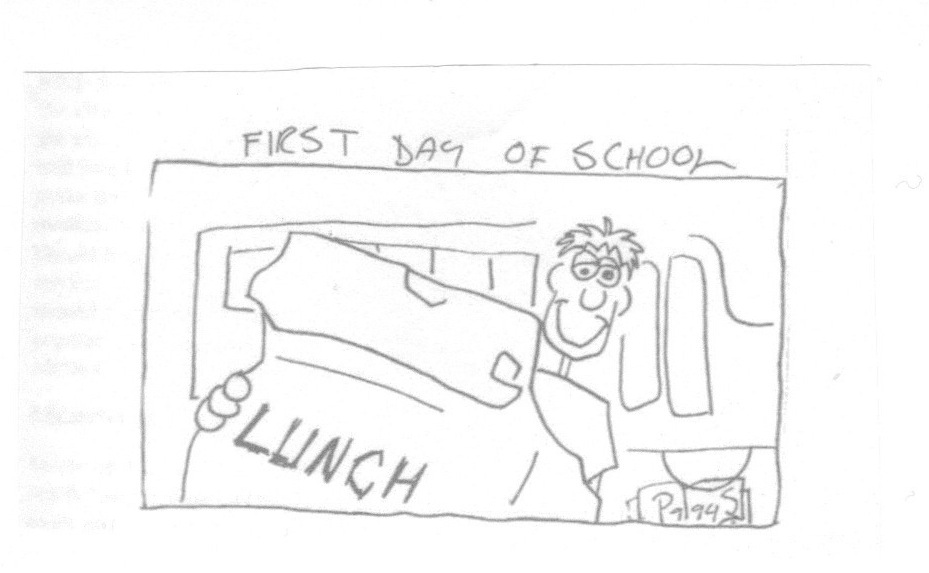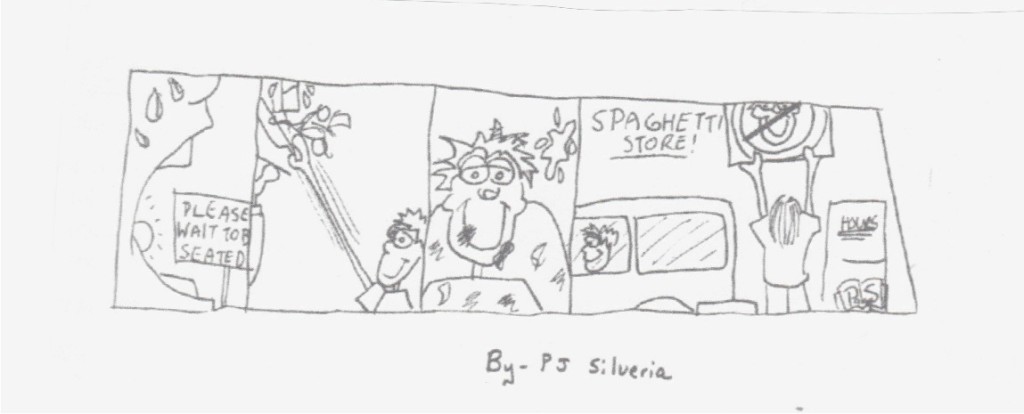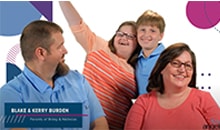A B C D E F G H I J K L M N O P Q R S T U V W X Y Z
See the complete list of topics.
Hair Cutting | Hair Pulling | History of Angelman Syndrome | Humor | Hypopigmentation
Hair Cutting
Angelman Family Contributions
I stand my son in front of the bathroom sink – filled with water, of course – and he becomes so distracted splashing and playing that if I work fast, he barely notices that I am trimming his hair.
AS Family Member
I have a “three step hair cutting plan”: 1) Put the “torture” chair in front of the TV and play a favorite video; 2) Keep a stock of favorite snacks on hand. Food is the great distracter; and 3) If all else fails, get a sibling to entertain your child! This doesn’t make the process easy… just easier!
AS Family Member
I cut my adult son’s hair and it is fun. My tip to avoid hair getting all over is to put a slick windbreaker jacket on backwards with the snaps or zipper in back. The hair easily falls off. Then I put baby powder on Frank’s skin to help the hair brush off. Also use the baby powder after a walk on the beach for legs, hands, and feet to help the sand fall right off.
Daniele, angel Frank
My tip here may not work for everyone, but I cut my girl’s hair myself. I’m not trained, but I have figured out that when I’m at home and can have someone help distract her, I do better than many who have tried at a salon to cut her hair. The main reason is that I have plenty of time and don’t feel rushed to finish. Get a good set of shears and maybe give it a go.
Sarah, bnamommyisfun@yahoo.com, angel Lily, age 14, Del+
Hair Pulling
Angelman Family Contributions
My daughter goes through times of intense hair pulling, most recently leaving a small bald spot on her pretty head. Here’s what we do when it starts and lingers more than a couple days: 1. We take her to a pediatrician to rule out infections, and we have him check her ears, nose, throat, and tummy. 2. We often take her to a dentist to rule out a cavity. 3. If these check out, we try Advil for a possible headache. The last episode was so bad and none of the above helped. So we cut her hair very short (she looks very cute), and we changed shampoo (Aveeno Sensitive Scalp). These two things have helped and for now have curbed her hair pulling. We are guessing her head may have been incredibly itchy. Final note: I always look at the hair-pulling as a means to communicate that she is uncomfortable. I do not treat it as a negative attention-seeking behavior. I think of my other verbal kids and wonder what they might be reacting to if they were pulling their hair and crying.
Sarah, bnamommyisfun@yahoo.com, angel Lily, age 14, Del+
Tickle your angel for a quick release! This is a quick and effective technique when your angel is grasping someone’s hair in public!
Alice, sandiegoasfwalk@gmail.com, angel Whitney, age 38, Del+
History of Angelman Syndrome and the ASF
See the Angelman Syndrome and ASF history timeline.
1965: Discovery of AS
Dr. Harry Angelman, an English physician at Warrington General Hospital, published a research paper that first described children with characteristics of Angelman syndrome. At that time, he referred to the disorder as “Happy Puppet Syndrome.” The condition was considered to be extremely rare at that time, and many physicians doubted its existence. This discovery, in theory, was the birth of AS.
1982: AS Diagnoses
Dr. Charles Williams and Dr. Jaime Frias of the University Of Florida College Of Medicine saw their first patients whom they believed had “Happy Puppet Syndrome” (now known as Angelman syndrome) based on Dr. Angelman’s past observations. It became clear that the condition was more common than previously thought. Dr. Williams and Dr. Frias proposed to change the name of this disorder to Angelman syndrome, in honor of Dr. Harry Angelman’s initial findings in 1965.
1987: Genetic Marker Identified
Ellen Magenis, physician at the Oregon Health Science Center, discovered a genetic “marker” for AS – a missing genetic code on a tiny portion of chromosome 15.
1989-1998: Volunteers Managed the ASF
1991: First Major Gift
Former Major League Baseball pitcher, Bryan Harvey, donated $20,000 to the ASF for AS research and family support.
1992: ASF Incorporated
The ASF was officially incorporated, which was the start of 25 years of commitment to research to discover AS treatments and a cure, and supporting families.
1992: Fresno, CA Mini-Conference
Pioneering California families gather “in the middle” and host a two day mini-conference at a local elementary school. Dr. Hutchinson, a local neurologist speaks along with other physicians.
1993: First ASF Conference in Orlando, Florida
The ASF hosts its first official Family Conference as an incorporated organization, with hundreds of families attending. Dr. Harry and Audrey Angelman attend the conference and are honored to meet “their children”. An ASF Board of Directors was elected.
1994: California families gather at Anaheim Stadium in Anaheim, CA
Bryan and Lisa Harvey hosted the event. The families attended a California Angels ballgame and relief pitcher, Bryan Harvey sealed the victory! Before the game, the families were invited into the dugout to meet the players where there were autographs signed and photos taken!
1995: Second ASF Conference in Colorado Springs, Colorado
There was an 80th birthday celebration for Dr. Angelman, but sadly he was unable to attend after being diagnosed with cancer.
1996: Dr. Angelman passes on August 8, 1996. He was born on August 13, 1915.
1996: Facts About AS, Dr. Charles Williams, Dr. Sarika Peters, Dr. Stephen Calculator
Facts About Angelman syndrome was published: the first-ever comprehensive resource for families for everything known about AS at that time in history.
1996: First Clinical TrialThe ASF formed its Scientific Advisory Committee, awarding ASF’s first-ever research grant to Dr. Joseph E. Wagstaff to investigate disturbed sleep patterns. This was the first clinical treatment trial in AS research, using melatonin for sleep disturbances.
1997: Mutations Discovered
Dr. Arthur Beaudet discovered mutations in the UBE3A gene as the cause of AS. This discovery quickly led to the development of animal models and active neuroscience research aimed at discovering how abnormalities of UBE3A cause impairment in neural development.
1997: First Scientific Symposium and Family Conference Seattle, Washington
The ASF holds the first Scientific Symposium in conjunction with the 1997 Family Conference in Seattle, Washington. This two-day symposium is a chance for leading researchers, scientists and doctors to discuss the latest research activities in the world of AS. In 2008, the Scientific Symposium became an annual event.
1998-2003: ASI Association Management Company, ASF
1999: Audrey Angelman passes. February 2, 1936 – August 15, 1999
1999: Inaugural Walk
The ASF hosts its inaugural ASF Walk, where more than 200 people walked five miles in Naperville, IL and raised nearly $25,000. The Walk now has more than 10,000 annual participants at nearly 50 sites across North America, including Canada and Mexico.
1999: Harry & Audrey Angelman Award
The first Harry and Audrey Angelman Award for Outreach and Education was announced by the ASF, honoring the Angelmans for their immense contributions to our community.
2000: ASF Website Launch
2000: Claudia Benton Research Award
The Dr. Claudia Benton Award for Research was announced by the ASF to honor Claudia Benton, who passed away in 1998. The award recognizes those with a strong commitment to advancing the scientific knowledge and understanding of AS or makes a significant impact on the lives of individuals with AS through research.
2003: Eileen Braun named Executive Director of the ASF
Sheila Wenger assisted Eileen with the ASF Walk, Special Events Coordinating, Member Services, and the ASF Biennial Family Conferences.
2004-Present: ASF is Self-Managed
2011: Paternal UBE3A Activated
Dr. Ben Philpot proved the paternal copy of UBE3A can be activated, a huge breakthrough in AS research. As discovered by Dr. Art Beaudet in 1996, AS is caused by a deficiency of UBE3A, so Dr. Philpot’s finding was a very significant and promising step towards better treatments and a cure.
2007: $1 Million Milestone
The ASF achieved a major milestone in AS research by hitting $1 million invested.
2009: $1 Million in Research
The ASF funded more than $1 million in research in one year for the first time. More than $1 million in grants were awarded to six principle investigators focusing on AS research.
- Benjamin Philpot, PhD – University of North Carolina Chapel Hill
- John Marshall, PhD – Brown University, Providence, RI
- Eric Klann, PhD – New York University
- Peter Howley, MD – Harvard Medical School
- Yong-Jui Jiang, MD, PhD – Duke University, Durham, NC
- Scott Dindot, PhD – Texas A&M University, College Station, TX
2012: AS Clinics Established
2013: International Angelman Day
International Angelman Day was celebrated for the first time to help raise awareness for AS across the world. That year alone, ASF Facebook posts were shared more than 1,000 times, introducing AS to thousands of people for the very first time.
2013: iPads for AS
The iPads for AS initiative enabled the ASF to award 100 iPads to individuals with AS for communication aids.
2013: $5 Million Milestone
ASF funded research reached $5 million invested. In 2013, the ASF committed over $200,000 to fund Angelman syndrome research putting the cumulative amount invested to over $5 million!
2014: ASOs Activate Paternal UBE3A
Dr. Art Beaudet builds on Dr. Philpot’s paternal UBE3A activation discovery, using antisense oligonucleotides (ASO) to activate paternal UBE3A. This successful research moved us even closer to a therapeutic.
2015: AS Clinic at Mayo Clinic
Mayo Clinic invested in AS research by opening its own AS Clinic in Rochester, Minn., on November 30, 2015, marking the third AS Clinic available to families in the U.S.
2015: Communication Training Series
The ASF Communication Training Series started, a program designed for families to help their individual with AS reach his or her greatest communication success. To date, more than 53,110 people have participated in these webinars.
2016: Center for Courageous Kids
The ASF organized and funded its first Center for Courageous Kids (CCK) outing, a fully-inclusive camping experience for 30 AS families. The ASF funded a second outing in April 2017.
2017: Biomarker Identified for Clinical Trials
ASF-funded research, published in the Journal of Neurodevelopmental Disorders, identified that delta—a frequency of brain rhythms identifiable by EEG scans—can serve as a reliable biomarker for pre-clinical and clinical trials in Angelman syndrome, one of the first biomarkers to be established in AS research. Biomarkers play a critical role in determining whether a potential therapeutic is effective, and this study gave the AS research community a viable tool to measure success of many trials!
2018: $10 Million Milestone
ASF funded research reached $10 Million invested. With so many advances being made in Angelman research by talented, dedicated professionals, the ASF is striving to have $10 million invested in AS research during the year 2018.
2019: Amanda Moore becomes the first CEO of the Angelman Syndrome Foundation
2019: ASF Family Fund
The ASF Family Fund was created. This allows families to apply for funds to gain access to resources needed to improve the quality of life for an individual with Angelman syndrome. Applications for funding are open twice a year in October and April.
Humor
Angelman Family Contributions
Humor is a huge coping mechanism because if we did not laugh at some of the things our angel does, we would probably cry.
AS Family Member
***Appeared in the 1999 edition, Angelman Syndrome from A to Z. Artist P.J. has a sibling with Angelman Syndrome.
 ***Appeared in the 1999 edition, Angelman Syndrome from A to Z.
***Appeared in the 1999 edition, Angelman Syndrome from A to Z.
In church several years ago, the family went to the altar for communion. We take our angel David with us and give him some of the bread. However, he won’t drink the grape juice. On this Sunday we were getting back into our pew when David had to sneeze. Well, the poor gentleman sitting in front of us was splattered. He had bread on his jacket and in his hair. Fred was picking bread out of his hair while the rest of the family was trying to keep from joining David in laughter. The poor man was very gracious, but has never sat in front of us again! We, and other church members, still have a laugh when we think of it!
Fred and Carolyn Windbeck Silver Spring, Maryland angel David, age 29
If an Angel could speak, this is what they’d probably say:
- Here are the rules of the game… I throw it behind the couch and you go find it!
- Do you really need that full head of hair?
- Let’s have another slumber party tonight!
- Surprise! I understand everything you say, so be careful!
- If I hear the sound of the microwave, I expect food!
- I am a lot smarter than you think, and I hide it sometimes to get out of WORK!
- When I laugh hysterically, it really, really IS funny!
- Someday I am going to hold you down, trim your fingernails, and see how YOU like it!
- A swimming pool =water= FUN TIME!
- Don’t be in such a hurry to take me out of the bathtub!
- I see an iPad; I HAVE TO HAVE IT!
- If you take me out of my routine, I am really NOT going to be happy!
- Sometimes I just want to be a kid!
- Babies are OK… as long as I AM THE CENTER OF ATTENTION!
- Could we take the TRAIN next time instead of the PLANE?
- I have to confess; sometimes it really is my fault instead of my sibling’s!
- I’ll take the macaroni and cheese!
- Wish you didn’t have to work so hard taking care of me!
- Never give up on me!
- Sometimes you go a little overboard with the “I love yous”; but the truth is, I really love you a lot, too!
Hypopigmentation
The following is an exerpt from Facts about Angelman Syndrome, written by Charles A. Williams, M.D. and Sarika U. Peters, Ph.D.
When AS is caused by the large deletion, skin and eye hypopigmentation usually result. This occurs because there is a pigment gene (the P gene, also termed OCA2), located close to the AS gene, that is also missing [75]. This pigment gene produces a protein that is believed to be crucial in melanin synthesis. Melanin is the main pigment molecule in our skin. In some children with AS, this hypopigmentation can be so severe that a form of albinism is suspected [76]. When AS is caused by the other genetic mechanisms, this gene is not missing and thus normal skin and eye pigmentation is seen. Children with AS who have hypopigmentation are sun sensitive, so use of a protective sun screen is important. Not all AS children with deletions of the P gene are obviously hypopigmented, but may only have relatively lighter skin color than either parent.
Surveys of individuals with AS demonstrate an increased incidence of strabismus. This problem appears to be more common in children with hypopigmentation (as above), since pigment in the retina is crucial to normal development of the optic nerve pathways. Management of strabismus in AS is similar to that in other children: evaluation by an ophthalmologist, correction of any visual deficit, and where appropriate, patching and surgical adjustment of the extraocular muscles. The hypermotoric activities of some AS children will make wearing of patches or glasses difficult but many are able to accomplish this.






